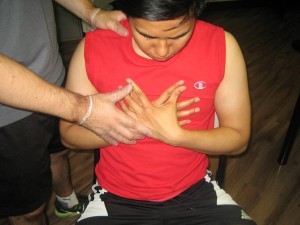The sternum is also known as the breast bone which is located in front of the chest and connected to the 12 ribs on either side and forms the thoracic griddle. The thoracic griddle functions in protecting the internal organs such as the heart and lungs from injuries. The sternum also helps protect the thymus which is a gland that produces hemopoetic stem cells.
A fractured sternum can either be due to a forceful blunt injury or a weakened sternum due to underlying conditions. People suffering from this condition can feel a severe pain in the middle chest and difficulty in breathing.
Causes
- Vehicular accidents without airbags and seatbelts
- Playing contact sports such as football
- Suffering from diseases that cause weakening of the bone or pathologic fracture
- Suffering from osteoporosis is prone to this injury if they are hit in the chest wall using a mild force.
Symptoms of fractured sternum

- Severe pain that becomes worse especially when coughing and sneezing.
- Tenderness, bruising and swelling of the affected area
- Crepitus is a crunching sound that can be heard when broken ends of the bones are rubbing against each other. Crepitus usually happens when there is displacement or instability of the broken sternum.
- Deformity of the ribcage
- Pain is severe especially when lying in certain positions such as facing down or sideways
Treatment
- Encourage the individual to rest to help with the fast healing of the affected area in 2-3 months. Avoid performing strenuous activities in order to prevent making the condition worse.
- Apply an ice pack on the affected area to help lessen the swelling and pain. Wrap a few ice cubes in a towel and pat it over the affected area at least 20 minutes every two hours. Avoid applying ice directly on the skin in order to help prevent frostbite.
- Take the prescribed anti-inflammatory medication in order to help lessen the swelling and pain.
- Avoid applying pressure on the area and performing weightlifting or any other activities that places plenty of stress to the bone.
- Perform exercises to improve posture, strength and flexibility to prevent the development of stiffness and weakness of the affected area.
- Gradually return to activities or sports by wearing protective padding or chest guards to help minimize injuries on the sternum and prevent it from getting worse.
Exercises
Shoulder blade squeezes – start by sitting or stand tall with the back in a straight position. Squeeze the shoulder blade as far as possible without pain and remain in that position for 1-2 seconds and repeat at least 10 times. Just make sure that the symptoms will not worsen.
Perform deep breathing by sitting or standing tall and the back in straight position. Breathe in as deeply as possible without increasing the symptoms and then relax. Inhale with the lower lungs instead of elevating the shoulders and gently expand the stomach at least five times.
